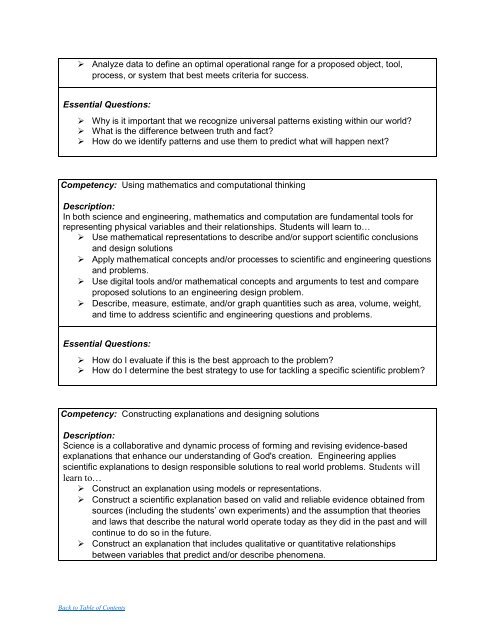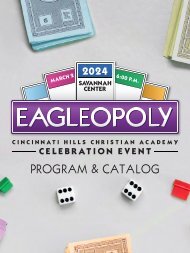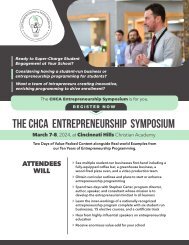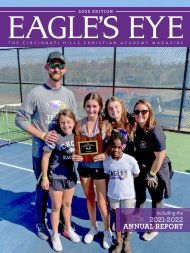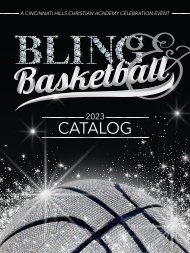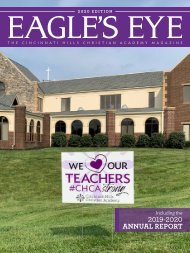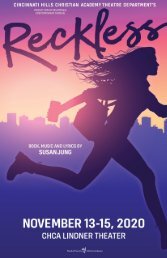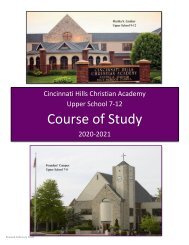Mission, Vision, Competencies, Standards, and Benchmarks
A Statement of Curriculum CINCINNATI HILLS CHRISTIAN ACADEMY Edyth B. Lindner Campus Otto Armleder Memorial Education Center Founders’ Campus Martha S. Lindner Campus 2019 Edition
A Statement of Curriculum
CINCINNATI HILLS CHRISTIAN ACADEMY
Edyth B. Lindner Campus
Otto Armleder Memorial Education Center
Founders’ Campus
Martha S. Lindner Campus
2019 Edition
Create successful ePaper yourself
Turn your PDF publications into a flip-book with our unique Google optimized e-Paper software.
‣ Analyze data to define an optimal operational range for a proposed object, tool,<br />
process, or system that best meets criteria for success.<br />
Essential Questions:<br />
‣ Why is it important that we recognize universal patterns existing within our world?<br />
‣ What is the difference between truth <strong>and</strong> fact?<br />
‣ How do we identify patterns <strong>and</strong> use them to predict what will happen next?<br />
Competency: Using mathematics <strong>and</strong> computational thinking<br />
Description:<br />
In both science <strong>and</strong> engineering, mathematics <strong>and</strong> computation are fundamental tools for<br />
representing physical variables <strong>and</strong> their relationships. Students will learn to…<br />
‣ Use mathematical representations to describe <strong>and</strong>/or support scientific conclusions<br />
<strong>and</strong> design solutions<br />
‣ Apply mathematical concepts <strong>and</strong>/or processes to scientific <strong>and</strong> engineering questions<br />
<strong>and</strong> problems.<br />
‣ Use digital tools <strong>and</strong>/or mathematical concepts <strong>and</strong> arguments to test <strong>and</strong> compare<br />
proposed solutions to an engineering design problem.<br />
‣ Describe, measure, estimate, <strong>and</strong>/or graph quantities such as area, volume, weight,<br />
<strong>and</strong> time to address scientific <strong>and</strong> engineering questions <strong>and</strong> problems.<br />
Essential Questions:<br />
‣ How do I evaluate if this is the best approach to the problem?<br />
‣ How do I determine the best strategy to use for tackling a specific scientific problem?<br />
Competency: Constructing explanations <strong>and</strong> designing solutions<br />
Description:<br />
Science is a collaborative <strong>and</strong> dynamic process of forming <strong>and</strong> revising evidence-based<br />
explanations that enhance our underst<strong>and</strong>ing of God's creation. Engineering applies<br />
scientific explanations to design responsible solutions to real world problems. Students will<br />
learn to…<br />
‣ Construct an explanation using models or representations.<br />
‣ Construct a scientific explanation based on valid <strong>and</strong> reliable evidence obtained from<br />
sources (including the students’ own experiments) <strong>and</strong> the assumption that theories<br />
<strong>and</strong> laws that describe the natural world operate today as they did in the past <strong>and</strong> will<br />
continue to do so in the future.<br />
‣ Construct an explanation that includes qualitative or quantitative relationships<br />
between variables that predict <strong>and</strong>/or describe phenomena.<br />
Back to Table of Contents


